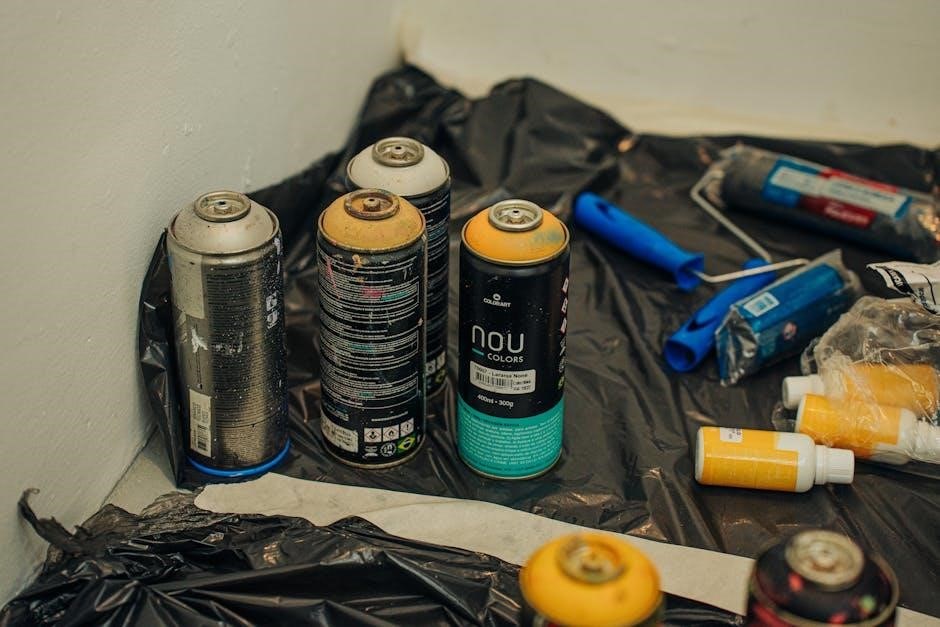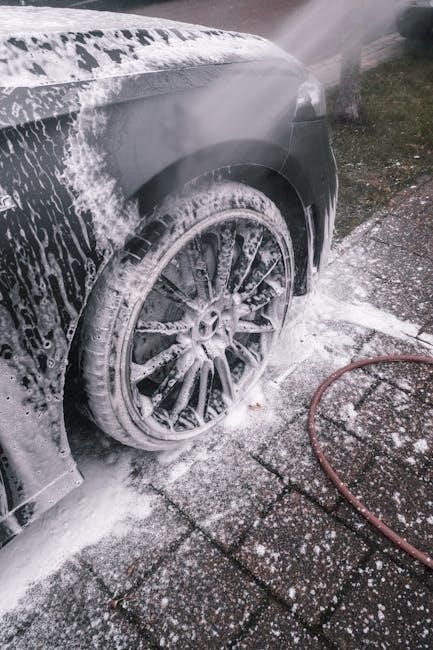pressure washer nozzle chart pdf

A pressure washer nozzle chart is a guide to selecting the optimal nozzle size for your machine; It helps balance GPM (gallons per minute) and PSI (pounds per square inch) for efficient cleaning without damaging surfaces or overworking your equipment․ These charts are essential for ensuring proper performance and extending the lifespan of your pressure washer․ By understanding how to read and use a nozzle chart, you can achieve better cleaning results while maintaining equipment health․
What is a Pressure Washer Nozzle Chart?
A pressure washer nozzle chart is a visual guide that helps users determine the correct nozzle size for their pressure washer based on its operating specifications․ It typically displays relationships between PSI (pounds per square inch) and GPM (gallons per minute) to ensure optimal performance․ The chart is organized in a table format, with rows representing PSI levels and columns indicating GPM flow rates․ By aligning these values, users can identify the appropriate nozzle orifice size․ This tool prevents overloading the machine and ensures efficient cleaning without damaging surfaces․ Printable PDF versions of these charts are widely available online, making it easy for users to reference them while selecting the right nozzle for their specific tasks․
Why is a Nozzle Chart Important for Pressure Washing?
A nozzle chart is crucial for ensuring safe and effective pressure washing․ It helps users select the right nozzle size, preventing damage to the machine or surfaces․ Using a nozzle that’s too small can overload the pressure washer, while one that’s too large may reduce cleaning efficiency․ The chart aligns the machine’s PSI and GPM with the ideal nozzle orifice size, optimizing performance․ This prevents overworking the pump and ensures proper water flow for the task․ By referencing the chart, users can avoid costly repairs and achieve better cleaning results․ It’s an essential tool for maintaining equipment longevity and achieving professional-grade cleaning outcomes across various surfaces and jobs․

Understanding Key Concepts
Key concepts include GPM (gallons per minute), PSI (pounds per square inch), and nozzle orifice size․ These elements determine water flow and pressure, essential for optimal cleaning performance and equipment safety․
What is GPM (Gallons Per Minute)?
Gallons Per Minute (GPM) measures the water flow rate of a pressure washer․ It indicates how much water the machine delivers per minute, crucial for determining cleaning efficiency․ Higher GPM means more water volume, which is beneficial for heavy-duty tasks․ However, excessive GPM can waste water and energy․ When using a pressure washer nozzle chart, GPM helps match the correct nozzle size to your machine’s specifications, ensuring optimal performance․ Balancing GPM with PSI (Pounds Per Square Inch) is essential for effective cleaning without overloading the equipment․ Proper GPM and nozzle size selection prevent damage and enhance cleaning results, making it a vital factor in pressure washer operations․
What is PSI (Pounds Per Square Inch)?
PSI (Pounds Per Square Inch) measures the pressure output of a fluid, such as water, from a pressure washer․ It indicates the force of the water stream, which determines cleaning effectiveness․ Higher PSI is ideal for tough surfaces like concrete, while lower PSI is better for delicate surfaces like wood or vehicles․ PSI, along with GPM (Gallons Per Minute), is a critical factor in selecting the right nozzle size using a pressure washer nozzle chart․ Proper PSI ensures efficient cleaning without damaging surfaces or overloading the machine․ Balancing PSI with GPM is essential for optimal performance and longevity of your pressure washer․
How GPM and PSI Relate to Nozzle Size
GPM (Gallons Per Minute) and PSI (Pounds Per Square Inch) are critical factors in determining the appropriate nozzle size for your pressure washer․ A higher GPM requires a larger nozzle orifice to maintain optimal flow, while higher PSI can be achieved with a smaller orifice․ The relationship between these two metrics ensures efficient cleaning without overloading the machine․ Using a pressure washer nozzle chart, you can match your machine’s GPM and PSI to the correct nozzle size; This balance is essential for achieving the best cleaning results while protecting your equipment from damage․ Proper alignment of GPM and PSI with nozzle size ensures optimal performance and longevity of your pressure washer․
The Role of Nozzle Orifice Size
The nozzle orifice size plays a crucial role in determining the performance of your pressure washer․ It regulates the water flow rate and pressure output, ensuring efficient cleaning․ A larger orifice allows more water to flow, reducing pressure, while a smaller orifice increases pressure but restricts flow․ Selecting the correct orifice size is essential to avoid damaging surfaces or overloading the machine․ Using a pressure washer nozzle chart, you can match the orifice size to your machine’s GPM and PSI specifications; Proper sizing ensures optimal cleaning efficiency and protects your equipment from excessive wear․ Incorrect orifice sizes can lead to reduced cleaning effectiveness or increased strain on the pressure washer’s motor․

Types of Pressure Washer Nozzles
Pressure washer nozzles come in various types, including Quick Connect, Flat, Variable, Sprinkler, and Specialty nozzles, each designed for specific cleaning tasks and surfaces․ They offer versatility and precision in cleaning applications․
Quick Connect Nozzles
Quick Connect nozzles are a popular choice for pressure washing due to their ease of use and versatility․ These nozzles feature a universal connection system, allowing for quick and effortless changes without tools․ They are ideal for a wide range of cleaning tasks, from light-duty jobs like washing vehicles to heavy-duty applications such as industrial cleaning․ Quick Connect nozzles are available in various orifice sizes, enabling users to adjust the flow rate and pressure to suit different surfaces and cleaning needs․ Their durability and compatibility with most pressure washer systems make them a favorite among both residential and commercial users․ Additionally, they often come with color-coded orifice sizes, simplifying the selection process for optimal cleaning efficiency․
Flat Nozzles
Flat nozzles are a common type of pressure washer nozzle, known for their wide, fan-shaped spray pattern and high-pressure output․ They are often used for cleaning large, flat surfaces such as driveways, sidewalks, and building exteriors․ These nozzles are designed with a plastic guard to protect the orifice from debris and typically feature a male plug for quick connection to pressure washer wands․ Flat nozzles are durable and versatile, making them suitable for both residential and commercial applications․ They come in various orifice sizes, allowing users to adjust the flow rate and pressure to match the cleaning task․ By referring to a nozzle size chart, users can select the ideal flat nozzle for their specific pressure washer’s PSI and GPM specifications, ensuring efficient and effective cleaning results․
Variable Nozzles
Variable nozzles are highly versatile and adjustable, allowing users to change the spray pattern and pressure output without switching nozzles․ These nozzles are ideal for tasks that require different cleaning intensities, such as washing delicate surfaces like vehicles or tackling tough stains on concrete․ By adjusting the orifice size, variable nozzles can deliver a wide range of flow rates and pressures, making them suitable for both residential and light commercial use․ They are often favored for their convenience and flexibility, eliminating the need to carry multiple nozzles․ However, proper adjustment is crucial to avoid damaging surfaces or reducing cleaning efficiency․ A nozzle size chart can help users determine the optimal setting for their specific pressure washer’s GPM and PSI, ensuring effective and safe cleaning results․
Spray Nozzles
Spray nozzles are designed to deliver a wide fan pattern, making them ideal for cleaning large surfaces or sensitive areas that require a gentle touch․ These nozzles are commonly used for tasks like washing vehicles, windows, and siding, where a soft yet effective spray is necessary․ Spray nozzles typically operate at lower to medium pressures, making them suitable for delicate surfaces without sacrificing cleaning power․ They are available in various orifice sizes, which can be selected using a pressure washer nozzle chart to ensure the correct balance of flow rate and pressure for the job․ By choosing the right spray nozzle, users can achieve a thorough clean while protecting surfaces from damage․ This makes them a versatile and essential tool for many residential and light-duty cleaning applications․
Specialty Nozzles
Specialty nozzles are designed for unique or demanding cleaning tasks that require more than standard nozzle capabilities․ These nozzles often feature advanced designs, such as adjustable patterns, rotational cleaners, or high-temperature compatibility, making them ideal for industrial or heavy-duty applications․ For example, some specialty nozzles are built to handle abrasive materials or chemicals, while others are engineered for precision cleaning in tight spaces․ They are commonly used in industries like manufacturing, agriculture, or construction, where standard nozzles may not suffice․ When selecting a specialty nozzle, it’s crucial to consult a pressure washer nozzle chart to ensure compatibility with your machine’s PSI and GPM specifications․ This ensures optimal performance and prevents equipment damage, making specialty nozzles a valuable addition for specialized cleaning jobs․

How to Select the Right Nozzle
Selecting the right nozzle involves determining the surface type, matching your pressure washer’s PSI and GPM specs, and using a nozzle size chart for accuracy․ Always avoid common mistakes like oversized or undersized nozzles to ensure optimal cleaning efficiency and machine performance․
Determining Surface Type
Identifying the surface type is crucial for selecting the right nozzle․ Hard surfaces like concrete can withstand high-pressure jets, requiring larger orifices․ For softer materials like wood or vehicles, narrower nozzles with lower pressure are essential to prevent damage․ Delicate surfaces may need specialized nozzles with wide fan angles to distribute pressure evenly․ Understanding the surface type ensures effective cleaning while protecting the material from wear․ Using a nozzle chart helps match the surface requirements with the appropriate nozzle size, optimizing both cleaning efficiency and surface safety․ This step is fundamental for achieving professional results in various cleaning tasks․
Matching Nozzle Size to Pressure Washer Specs
Matching the nozzle size to your pressure washer’s specifications ensures optimal performance․ Use the machine’s PSI and GPM ratings to determine the correct orifice size․ A nozzle that’s too small can restrict flow, overloading the pump, while one too large may reduce pressure, weakening the cleaning power․ Refer to a nozzle chart to find the ideal size based on your washer’s output․ Proper alignment enhances efficiency, prevents equipment strain, and ensures effective cleaning․ Always consult the chart to avoid mismatching, which can lead to poor results or machine damage․ This step is vital for maximizing the effectiveness and longevity of your pressure washer․
Using a Nozzle Size Chart
A nozzle size chart simplifies the process of selecting the correct nozzle for your pressure washer․ These charts typically display PSI (Pounds Per Square Inch) and GPM (Gallons Per Minute) ratings, allowing you to determine the appropriate orifice size․ To use the chart, identify your pressure washer’s PSI and GPM, then locate the corresponding nozzle size․ This ensures optimal performance and prevents issues like reduced pressure or overloading the machine․ Properly matching the nozzle size enhances cleaning efficiency and protects your equipment․ Many charts are available as printable PDFs, making them easy to reference during nozzle selection․ By following the chart, you can avoid underperformance and extend the lifespan of your pressure washer․
Impact of Nozzle Size on Cleaning Efficiency
Nozzle size significantly impacts cleaning efficiency by affecting water flow and pressure distribution․ A properly sized nozzle ensures optimal water pressure for the task, preventing surface damage and maximizing cleaning power․ Using a nozzle that is too small can restrict water flow, reducing efficiency and potentially overloading the machine․ Conversely, a nozzle that is too large may lower pressure, making cleaning less effective․ The right nozzle size balances PSI and GPM, ensuring efficient cleaning without wasting resources․ Incorrect nozzle sizes can lead to poor results, increased wear on the pressure washer, and higher operating costs․ Referencing a nozzle size chart helps achieve the ideal balance for specific cleaning tasks, enhancing overall performance and productivity․
Common Mistakes in Nozzle Selection
One of the most common mistakes in nozzle selection is choosing a size that does not match the pressure washer’s PSI and GPM specifications․ Using a nozzle that is too small can restrict water flow, leading to reduced cleaning efficiency and potential damage to the machine․ Conversely, a nozzle that is too large may lower the pressure, making cleaning less effective․ Many users also fail to consult a nozzle size chart, relying instead on guesswork, which often results in suboptimal performance․ Additionally, ignoring the surface type being cleaned can lead to using the wrong nozzle pattern, causing surface damage or inefficient cleaning․ Proper nozzle selection requires careful consideration of both machine specifications and the cleaning task at hand to ensure optimal results and equipment longevity․

Pressure Washer Nozzle Chart Details
A pressure washer nozzle chart provides a detailed guide to match your machine’s PSI and GPM with the correct nozzle orifice size for optimal performance․ These charts are often available as downloadable PDFs, offering a quick reference to ensure proper nozzle selection and machine efficiency․
How to Read a Nozzle Chart

Reading a pressure washer nozzle chart involves matching your machine’s PSI (pounds per square inch) and GPM (gallons per minute) to the correct nozzle orifice size․ Start by locating your pressure washer’s operating PSI and GPM in the chart․ Follow the row corresponding to your PSI to find the recommended orifice size that aligns with your GPM․ This ensures optimal water flow and pressure for efficient cleaning․ The chart may also provide color codes or labels for different nozzle types, such as wide fan or narrow streams․ Always refer to a printable PDF version for clarity and convenience․ Proper use of the chart prevents overworking your machine and ensures effective cleaning results․
Interpreting Orifice Size and PSI
Understanding the relationship between orifice size and PSI is crucial for optimal pressure washer performance․ A larger orifice allows more water flow, reducing operating pressure, while a smaller orifice restricts flow, increasing PSI․ Use a nozzle chart to match your machine’s specs․ For example, at 4 GPM, a 0․25-inch orifice delivers 2500 PSI, while a 0․30-inch orifice lowers it to 2000 PSI․ Too large an orifice can under-pressurize the system, reducing cleaning effectiveness․ Conversely, too small an orifice increases back pressure, risking machine damage․ Always reference a printable PDF chart to ensure the correct orifice size for your specific needs, balancing water flow and pressure for efficient cleaning without compromising equipment integrity․
Understanding Flow Rates on the Chart
Flow rates, measured in GPM (gallons per minute), are a key component of a pressure washer nozzle chart․ The chart helps users determine the correct orifice size based on their machine’s GPM and desired PSI․ Higher GPM requires a larger orifice to maintain optimal pressure, while lower GPM needs a smaller orifice․ For example, at 3 GPM, a 0․20-inch orifice delivers 3000 PSI, while at 4 GPM, a 0․25-inch orifice achieves 2500 PSI; Matching the correct orifice size to your machine’s flow rate ensures efficient cleaning performance and prevents equipment damage․ Always refer to a PDF chart for precise calculations, ensuring the right balance between water flow and pressure for your specific cleaning tasks․
Using the Chart for Optimal Performance
Using a pressure washer nozzle chart effectively ensures your machine operates at peak performance․ Start by identifying your pressure washer’s GPM and PSI ratings․ Match these values on the chart to find the recommended orifice size for your nozzle․ A larger orifice increases water flow but lowers pressure, while a smaller orifice restricts flow but boosts pressure․ Always choose a nozzle that aligns with your machine’s specifications to avoid underperformance or damage․ Refer to a PDF chart for precise measurements, as it provides detailed data for various PSI and GPM combinations․ Proper nozzle selection not only enhances cleaning efficiency but also protects your equipment from strain․ Regularly consult the chart to adapt to different cleaning tasks and maintain optimal results․

Practical Applications of Nozzle Charts
Nozzle charts are invaluable for various cleaning tasks, from residential washing to commercial and industrial applications․ They ensure optimal nozzle selection for efficient cleaning and surface protection, enhancing overall performance across diverse industries․
Residential Cleaning Tasks
Pressure washer nozzle charts are essential for homeowners tackling various cleaning projects․ From house washing and driveway cleaning to patio maintenance, the right nozzle ensures efficient results․ For delicate surfaces like windows or siding, a wider fan nozzle with lower PSI is ideal․ Conversely, narrow nozzles are better for tough stains on concrete or decks․ Using the correct nozzle size, as indicated by the chart, prevents damage to surfaces while optimizing water flow․ This makes residential cleaning tasks quicker and more effective, ensuring your home remains in top condition without unnecessary wear on your equipment․ The chart simplifies nozzle selection, helping you achieve professional-grade cleaning results for all your outdoor and indoor projects․

Commercial and Industrial Cleaning
Pressure washer nozzle charts are indispensable in commercial and industrial settings, where heavy-duty cleaning tasks are common․ These charts help professionals select the right nozzle size for high-pressure applications, ensuring optimal performance․ In industries like manufacturing, construction, and hospitality, different surfaces require specific nozzle configurations․ For instance, flat nozzles are ideal for large areas like factory floors, while variable nozzles are better for irregular surfaces․ The chart simplifies the process of matching nozzle orifice size to the machine’s PSI and GPM, ensuring efficient cleaning without damaging equipment or surfaces․ This is particularly important in industrial settings where downtime must be minimized․ By using the correct nozzle, businesses can maintain hygiene, extend equipment lifespan, and achieve consistent results across various cleaning tasks․
Vehicle and Equipment Washing
Pressure washer nozzle charts play a crucial role in vehicle and equipment washing by ensuring the right nozzle size is selected for specific tasks․ For cars, trucks, and machinery, using a nozzle that delivers the correct PSI and GPM prevents damage to paint, metal, and other surfaces․ The chart helps users identify the ideal nozzle orifice size for their equipment, balancing cleaning power with surface protection․ For example, a wide fan nozzle is perfect for large vehicles, while a narrower nozzle is better for detailed cleaning or removing stubborn stains․ Proper nozzle selection enhances cleaning efficiency and extends the lifespan of both the pressure washer and the vehicles being cleaned․ This ensures a safer, more effective washing process for all types of vehicles and equipment․
Specialized Cleaning Jobs
Pressure washer nozzle charts are invaluable for specialized cleaning tasks, such as graffiti removal, roof cleaning, and monument restoration․ These jobs often require precise control over water pressure and flow rate to avoid damage while ensuring thorough cleaning․ The chart helps users match their pressure washer’s PSI and GPM to the appropriate nozzle orifice size, ensuring optimal performance․ For instance, a smaller orifice is ideal for high-pressure tasks like concrete cleaning, while a larger orifice suits low-pressure jobs like delicate surface washing․ This tailored approach ensures efficiency and safety, making nozzle charts an essential tool for professionals tackling unique or demanding cleaning projects․ Proper nozzle selection enhances results and protects surfaces, making it a critical step in specialized cleaning scenarios․

Troubleshooting and Maintenance
Identify issues like clogged nozzles or incorrect sizes using a pressure washer nozzle chart․ Regular cleaning and timely replacements ensure optimal performance and prevent equipment damage over time․
Signs of Incorrect Nozzle Size
Using the wrong nozzle size can lead to reduced cleaning efficiency, lower pressure output, and increased wear on your pressure washer․ If the nozzle is too small, it may cause the machine to overwork, leading to higher energy consumption and potential damage․ Conversely, a nozzle that is too large can result in insufficient pressure for effective cleaning․ Other signs include inconsistent water flow, excessive noise, or vibrations during operation․ Over time, incorrect nozzle sizing can shorten the lifespan of your pressure washer․ Always refer to a pressure washer nozzle chart to ensure you’re using the right size for your specific needs, preventing these issues and maintaining optimal performance․
How to Avoid Damage to Your Pressure Washer
To prevent damage to your pressure washer, always use the correct nozzle size as specified in the pressure washer nozzle chart․ Incorrect nozzle sizes can lead to reduced efficiency, increased wear, or even machine failure․ Ensure the nozzle orifice matches your washer’s PSI and GPM ratings․ A nozzle that is too small can overwork the pump, while one that is too large may result in insufficient pressure․ Regularly inspect and clean nozzles to avoid clogs, which can disrupt water flow and strain the system․ Additionally, store nozzles properly to prevent damage from debris or impact․ By following these guidelines, you can protect your equipment and maintain its performance for years to come․

Cleaning and Maintaining Nozzles
Regular cleaning and maintenance of pressure washer nozzles are crucial for optimal performance․ Use a soft brush or toothbrush to remove dirt and mineral deposits that can clog the orifice․ Soak the nozzle in a mixture of water and vinegar to dissolve stubborn buildup․ Avoid using harsh chemicals or abrasive materials that might damage the nozzle․ After cleaning, thoroughly rinse the nozzle with fresh water․ Store nozzles in a dry, protected area to prevent rust or corrosion․ By maintaining your nozzles, you ensure consistent water flow and pressure, extending the life of your pressure washer․ Refer to your pressure washer nozzle chart for specific care instructions tailored to your equipment․
When to Replace Nozzles
Determine when to replace nozzles by monitoring performance and inspecting for wear․ Signs include reduced water pressure, uneven spray patterns, or visible damage like cracks or corrosion․ If cleaning doesn’t restore function, it’s time to replace the nozzle․ Using a damaged or incorrect nozzle can lead to inefficient cleaning and potential damage to your pressure washer․ Refer to your pressure washer nozzle chart to select the correct replacement․ Regularly replacing worn-out nozzles ensures optimal performance and extends the lifespan of your equipment, maintaining both effectiveness and safety during cleaning tasks․
Using a pressure washer nozzle chart ensures optimal performance and safety․ For more detailed guides, visit Cam Spray or Pressure Washer Experts for printable charts and expert advice․
Understanding and using a pressure washer nozzle chart is crucial for optimal cleaning performance․ It helps match the correct nozzle size to your machine’s PSI and GPM, ensuring efficient cleaning without surface damage․ Always consider the surface type and your pressure washer’s specifications when selecting a nozzle․ Using the wrong size can reduce efficiency or damage your equipment․ Refer to a nozzle size chart for precise guidance․ Avoid common mistakes like choosing a nozzle too small or too large․ For detailed guidance, printable charts and expert advice are available from trusted sources like Cam Spray and Pressure Washer Experts․ This ensures you achieve the best results while maintaining your equipment’s longevity․
Where to Find Printable Nozzle Charts
Printable pressure washer nozzle charts are widely available online from trusted sources like Cam Spray and Pressure Washer Experts․ These charts are often provided in PDF format, making them easy to download and use․ Many manufacturers also offer nozzle size calculators and charts on their official websites․ Additionally, forums and professional cleaning communities share downloadable resources to help users select the right nozzle for their equipment․ Simply search for “pressure washer nozzle chart PDF” to find high-quality, printable versions․ These tools are indispensable for ensuring optimal performance and maintaining your pressure washer’s efficiency․ Always refer to these charts to make informed decisions for your cleaning tasks․